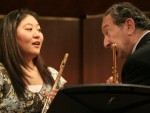Title
On October 5, the esteemed flutist Maxence Larrieu conducted a master class in Morse Hall. Born in 1934 in Marseille, France, Mr. Larrieu won the Premiere Prix de Flute at the Paris Conservatory in 1951 as a student of Gaston Crunelle, and in 1953, the Premiere Prix de Musique for chamber music. The following year he won the Concours International de Genève et Munich. By 1954, he held the position of solo flute of L’Opéra Comique de Paris. Since 1966, he has held teaching positions in Los Angeles and Geneva. Paralleling his success in competitions, Mr. Larrieu is a brilliant soloist who performs works with the world’s greatest orchestras.
Body
Six Juilliard students performed that afternoon, bringing a wide variety of style and repertoire to the class. Gloria Huh and Jeremiah Bills performed Reinecke’s Undine Sonata and Le Grande Fantasie de Mignon, by Thomas Ambrose, arranged by Paul Taffanel. Nadia Kyne and Chelsea Knox performed Chant de Linos by Jolivet and Lowell Liebermann’s Flute Concerto. Emily Thomas and Emi Ferguson performed Les Folie d’espagne by Marain Marais and Schumann’s Three Romances. Mr. Larrieu spoke in French for parts of the class, but his teachings were very much understood. “There is no French school. There is no German school and there is no American school,” he explained. “There are only good flutists.”
Mr. Larrieu emphasized the importance of having the performance reflect the style in which the piece was written, both in feel and in tone color. With different kinds of music, he explained, one must reflect that culture and style of playing: in French music, for instance, it is stylistically correct to be more free with the time, to play with more vibrato and to be more lyrical with the phrases, whereas in the Baroque style, it is more important to keep the time steady and use a tasteful and appropriate vibrato.
He also addressed every flutist’s nightmare: breathing. After an exaggerated impersonation of how many flutists breathe (which was playfully reminiscent of a panting canine), he said dryly, “You are a flutist, not a dog.” As the giggles subsided, he demonstrated with one long phrase from Reinecke’s Undine Sonata that the breath should become a part of the music; there is time to breathe, and therefore no need to rush. The audience, he told the flutists, needs to breathe as much as you do. When it was Ms. Huh’s turn to incorporate Mr. Larrieu’s teachings, not only was the phrase longer and smoother, but the breath became hardly noticeable.
The overarching theme of that afternoon was simply the beauty of the flute sound and music. “Everyone is obsessed with the big flute sound,” he said. “In an orchestra, of course, one needs a big sound. The conductor always says, ‘More! More!’…But I’m sorry,” he said, smiling at the audience. “The flute is not a trumpet.”
Mr. Larrieu explained that each note playable on the flute should be equal in color, beauty, and effort. He demonstrated with one of his sound exercises, which covered the entire range of the flute from low to high tones—each received equal attention and was equally brilliant and beautiful. His sound easily cut to the back of the auditorium without forcing or over-blowing.
Said Emily Thomas, one of the performers in the class, “The most important thing I got was to relax and make music—not to force or blow too much air, but to concentrate on a clear, centered sound that sings organically and is appropriate for the time period and compositional style.”
To be in the presence of such an experienced performer was exciting—especially one whose concepts and philosophies represent a long lineage of French flute playing. If one were to run into him by chance on the streets of New York or Paris, he might seem like any other friendly stranger one might encounter on a Sunday stroll: cordial, polite—a gentleman. But that Friday afternoon, Maxence Larrieu had a presence, a confidence, and a surplus of knowledge and information. He was the sage in artistry and performance, passing on his experience to the young artists of the future.





